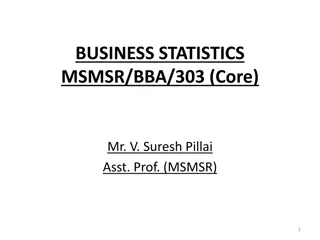
Industrial Engineering Sampling Methods Overview
Learn about different sampling methods used in industrial engineering, including probability sampling (such as simple random sampling, stratified sampling, cluster sampling) and non-probability sampling (like volunteer and judgmental sampling). Understand the principles behind simple random sampling, stratified sampling, and systematic sampling, along with practical applications in the field of industrial engineering.
Download Presentation

Please find below an Image/Link to download the presentation.
The content on the website is provided AS IS for your information and personal use only. It may not be sold, licensed, or shared on other websites without obtaining consent from the author. If you encounter any issues during the download, it is possible that the publisher has removed the file from their server.
You are allowed to download the files provided on this website for personal or commercial use, subject to the condition that they are used lawfully. All files are the property of their respective owners.
The content on the website is provided AS IS for your information and personal use only. It may not be sold, licensed, or shared on other websites without obtaining consent from the author.
E N D
Presentation Transcript
Industrial Engineering Design of Experiments (Lecture III) Dr. Adham Ragab
Industrial Engineering Sampling methods Probability Sampling: Sample has a known probability of being selected Simple Random Sampling (SRS) Stratified Sampling Cluster Sampling Systematic Sampling Multistage Sampling (in which some of the methods above are combined in stages)
Industrial Engineering Sampling methods Non-probability Sampling: Sample does not have known probability of being selected volunteer samples haphazard (convenience) samples Judgmental Sampling
Industrial Engineering Simple random sample A simple random sample (SRS) of size n is a sample chosen by a method in which each collection of n population items is equally likely to comprise the sample, just as in the lottery.
Industrial Engineering Stratified Sampling Stratified Sampling is possible when it makes sense to partition the population into groups based on a factor that may influence the variable that is being measured. These groups are then called strata. An individual group is called a stratum.
Industrial Engineering Stratified Sampling With stratified sampling one should: partition the population into groups (strata) obtain a simple random sample from each group (stratum) collect data on each sampling unit that was randomly sampled from each group (stratum)
Industrial Engineering Cluster Sampling With cluster sampling one should divide the population into groups (clusters). obtain a simple random sample of so many clusters from all possible clusters. obtain data on every sampling unit in each of the randomly selected clusters.
Industrial Engineering Systematic Sampling Systematic sampling: is a method in which sample members from a larger population are selected according to a random starting point and a fixed periodic interval. This interval, called, the sampling interval, is calculated by dividing the population size by the desired sample size.
Industrial Engineering Multistage Sampling In statistics, multistage sampling is the taking of samples in stages using smaller and smaller sampling units at each stage. Multistage sampling can be a complex form of cluster sampling because it is a type of sampling which involves dividing the population into groups (or clusters).
Industrial Engineering Histogram A histogram is a plot that lets you discover, and show, the underlying frequency distribution (shape) of a set of continuous data. This allows the inspection of the data for its underlying distribution (e.g., normal distribution), outliers, skewness, etc.
Industrial Engineering Histogram
Industrial Engineering Histogram A symmetric distribution is one in which the 2 "halves" of the histogram appear as mirror-images of one another. A skewed (non-symmetric) distribution is a distribution in which there is no such mirror-imaging.
Industrial Engineering Histogram A "skewed right" distribution is one in which the tail is on the right side.
Industrial Engineering Histogram A "skewed left" distribution is one in which the tail is on the left side.
Industrial Engineering Histogram An outlier is an observation that lies outside the overall pattern of a distribution
Industrial Engineering Box plot
Industrial Engineering Box plot






















